Managing the Digital You
Managing the Digital You
Where and How to Keep and Organize Your Digital Life
Melody Condron
Rowman & Littlefield
Lanham Boulder New York London
Published by Rowman & Littlefield
A wholly owned subsidiary of The Rowman & Littlefield Publishing Group, Inc.
4501 Forbes Boulevard, Suite 200, Lanham, Maryland 20706
www.rowman.com
Unit A, Whitacre Mews, 26-34 Stannary Street, London SE11 4AB
Copyright 2017 by American Library Association
All rights reserved. No part of this book may be reproduced in any form or by any electronic or mechanical means, including information storage and retrieval systems, without written permission from the publisher, except by a reviewer who may quote passages in a review.
Managing the Digital You: Where and How to Keep and Organize Your Digital Life is part of the Rowman & Littlefield LITA Guides series. For more information, see https://rowman.com/Action/SERIES/RL/LITA.
British Library Cataloguing in Publication Information Available
Library of Congress Cataloging-in-Publication Data
Names: Condron, Melody, 1979- author.
Title: Managing the digital you : where and how to keep and organize your digital life / Melody Condron.
Description: Lanham : Rowman & Littlefield, [2017] | Includes bibliographical references and index.
Identifiers: LCCN 2016047505 (print) | LCCN 2017003918 (ebook) | ISBN 9781442278875 (cloth : alkaline paper) | ISBN 9781442278882 (electronic)
Subjects: LCSH: Electronic recordsManagement. | Personal archivesManagement. | Digital media. | Digital communications.
Classification: LCC CD974.4 .C65 2017 (print) | LCC CD974.4 (ebook) | DDC 070.5/797dc23
LC record available at https://lccn.loc.gov/2016047505
 The paper used in this publication meets the minimum requirements of American National Standard for Information SciencesPermanence of Paper for Printed Library Materials, ANSI/NISO Z39.48-1992.
The paper used in this publication meets the minimum requirements of American National Standard for Information SciencesPermanence of Paper for Printed Library Materials, ANSI/NISO Z39.48-1992.
Printed in the United States of America
Contents
Preface
Things have changed. Just 20 years ago, managing your personal files may have consisted of keeping medical, legal, and personal papers in boxes or files for later access. Emergencies like flood or fire may lead to loss, but in general, files kept in a box or folder stayed where they were until you needed to use them. If you wanted to be extra vigilant, you could make copies or store them in a safe deposit box at the bank. Many people still follow these practices, but it is more difficult to maintain a fully physical system in the highly digitized world. Documents like licenses and deeds continue to be physical, but insurance paperwork, bank documents, and bills are increasingly digital. Personal correspondence, too, is predominantly email and SMS/text. Yet few of us are confident in our digital systems, and we are not backing things up. This leads to potential losses, not just through accident or theft, but also because of the known limited life of hardware and the inaccessibility of old software over time. Google Vice President Vint Cerf recently warned that a generation, or even a whole century, is at risk of being forgotten as the software and hardware holding with our communal and personal histories get older and die. This risk has birthed an interest in personal digital archiving.
Perhaps the largest challenge for all computer users is dealing with the volume. Virtually every service and tool requires an account for full access. With these multiple accounts come multiple passwords that we are not supposed to write down or share. We are also creating our own digital items faster than ever before. Blogger Benedict Evans calculates that over 2 trillion photographs were shared online in 2015a number larger than the estimate of all photos taken on physical film, ever . We additionally have hardware that fails as it gets older, software that changes with every update, and files that can become corrupted or lost in the large number of poorly named items on our hard drives.
So how do we manage this volume and chaos? How do we manage our multitude of accounts, overflowing emails, and digital items spread out across multiple devices and websites? People cope with the overwhelming digital environment in different ways, depending on their familiarity with computers and personal experiences. Generally, users learn to cope by coming up with custom solutions: things that work for them but may not make sense to anyone else. This may work for a while, but it ultimately means that no one can help you if you mix up something or if someone else needs to know how to manage your documents or accounts (such as in an emergency). Another common coping mechanism is to avoid digital options whenever possible. This isnt practical as things increasingly move online, creating a more difficult situation for people who eventually hit a situation that forces them to the computer. Finally, many computer users just never develop a system at all, or are inconsistent.
The truth is that there is no one best way to manage your files, because each of us have different needs and expectations. No one solution exists to address the common problems of having too many accounts, too many online systems, and too many digital documents. Instead there are many possible solutions that have worked for others, and are based on logic as well as trial and error. One of them may work for you.
Managing the Digital You can help. It will offer basic and practical solutions that are attainable and recommended by others with similar needs. It will help you identify and prioritize. Finally, it will offer tips and tools to get you started, even if you are not a computer expert and have limited funds.
How Did This Happen
You may wonder, How did things get so difficult? And how did we acquire so many digital files and photos so quickly? Where did all this stuff come from?! Part of the issue is that things have changed slowly, and most people have not adapted. The transformation happened over a matter of years, with small incremental changes that made it easy to ignore for a while. Then, suddenly, like a lobster in water thats been slowly getting hotter, we cant ignore it any longer. We reach a tipping point where our old systems that worked for a while just dont work anymore: we cant find anything, everything we try to do is frustrating, and we dont know how to fix it. It has gotten complicated in small parts, so that it is hard to go back and rebuild without losing things. Even more frustrating, you cant just scrap your computer and start over without losing photos and files you have tied up in your existing systems. Whether you embraced computers early on, or only use them when you must, there is no one silver bullet to help users grapple with the overwhelming number of options. There are thousands of applications available to organize photographs, for example. How do users assess so many tools? Where do they start? What can be done when there are new photos, documents, and emails being created every day on top of a backlog of items already spread out across multiple devices? Managing the Digital You will hopefully serve as an answer to these questions by giving users the basic tools they need to get started with personal digital archiving.
Reasons to Plan for Your Digital Items
Beyond the desire to get ahead of the mounting digital landslide, there are a number of good reasons to organize and manage your digital items in a meaningful way. You probably know many of them already, since you have picked up this book. While everyone will have their own personal reasons for wanting to manage and save their digital items, a few common themes emerge.
Next page
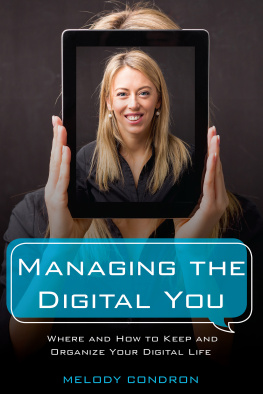




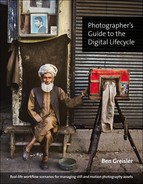
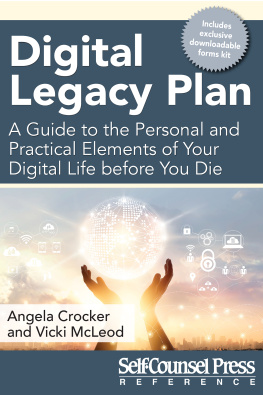
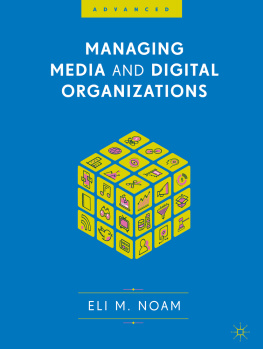
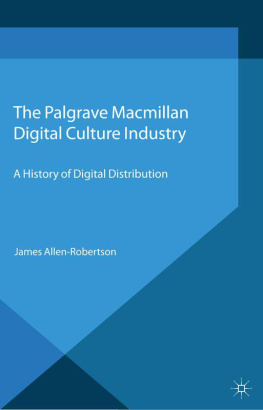
 The paper used in this publication meets the minimum requirements of American National Standard for Information SciencesPermanence of Paper for Printed Library Materials, ANSI/NISO Z39.48-1992.
The paper used in this publication meets the minimum requirements of American National Standard for Information SciencesPermanence of Paper for Printed Library Materials, ANSI/NISO Z39.48-1992.